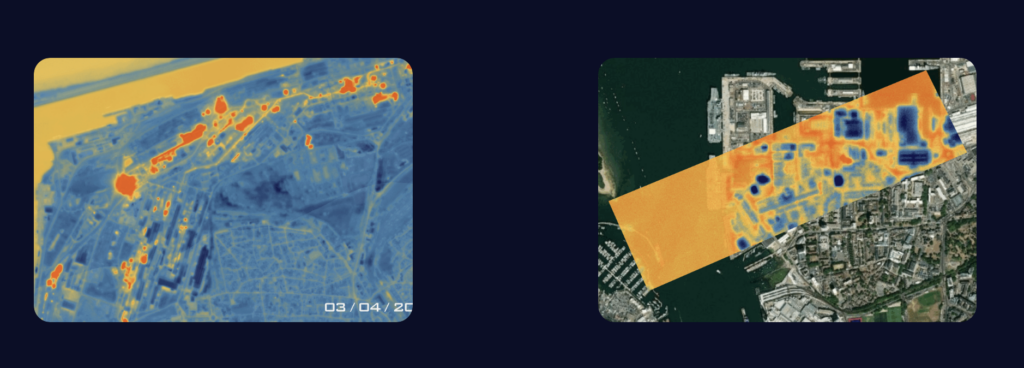

SatVu, the British climate tech company recently announced a significant achievement in space technology, releasing the First Light imagery from its revolutionary thermal imaging satellite, HOTSAT-1, at the same time as announcing their move into commercial operations. This milestone is a major step in Earth observation and climate monitoring.
HOTSAT-1, named in homage to its cutting-edge thermal imaging capabilities, was launched into orbit in June aboard a SpaceX rocket from the Vandenberg Space Force Base in California.
SatVu is now releasing their First Light imagery and video beginning a new era of data collection and analysis.
This represents a significant stride forward in SatVu’s mission to leverage space technology for climate and environmental insights as they launch commercial operations. As the first satellite in the planned constellation, HOTSAT-1 will provide invaluable and unique data enabling transformation in economic activities and energy efficiency, aligning seamlessly with global Net Zero goals and SDGs.

HotSat-1 Launch & Separation
HOTSAT-1’s initial images provide unique insights and new data layers across various geographical locations.
- In Canada – the imagery reveals active fire fronts (in this case, as at July 28th, 2023) vividly depicted in orange, enabling emergency responders organizations to predict speed of progression and potential paths of impact.
- The smoky aftermath, portrayed in a light blue hue, showcases the scorched terrain left in the fires’ devastating wake.
- Unlike previous images typically collected by current satellites, SatVu’s imagery uniquely uses high resolution thermal infrared wavelengths.
- This distinct perspective unveils a much higher resolution view of the area unobscured by smoke, which is impenetrable at visible wavelengths. This coupled with insight into course and speed derived from the video captured, means that firefighters can better manage the fire front safely by identifying and extinguishing small hidden fires. Moreover, the fact that SatVu’s images can also be captured during the night underscores the unprecedented potential of high resolution thermal infrared satellites as indispensable tools for global fire fighting activities.
- This visual account not only highlights the gravity of the situation but also serves as a catalyst for broader discussions on climate change, disaster response, and the urgent need for advanced monitoring technologies.
- In Chicago – images were captured with the potential to monitor rail logistics.
- The technology discerns locomotive thermal signatures and train speeds, offering crucial data for transportation and logistics optimization.
- This independent verification of data is key when monitoring net zero targets and optimization offers both energy and cost-saving value to customers .
- In Las Vegas – the high-resolution observations shed light on urban heat islands.
- This imagery delivers unprecedented access to heat island insights within local environmental planning.
- This information is invaluable as heat stress is having a catastrophic impact on populations globally and the urban heat island effect means we are currently wasting energy on excess cooling.
- In Cushing – the imagery highlights the benefits of industrial activity monitoring.
- This illustrates how SatVu’s technology can be used to monitor oil storage facilities and pipelines.
- This data will become invaluable for energy-related decision-making, providing unique insights on the operating capacity of facilities and offering the ability to ensure industrial regulations are being adhered to.
Anthony Baker, CEO and Co-founder, SatVu stated, “As we receive the First Light imagery from HOTSAT-1, we are thrilled to announce the transition of our thermal imaging satellite into commercial operation. This milestone not only reflects the dedication and hard work of our entire team but also underscores our commitment to using advanced technology for the betterment of our planet. HOTSAT-1’s ability to capture valuable thermal imagery with applications ranging from logistics optimization to environmental planning and energy-related decision-making is truly groundbreaking. With this achievement, we move forward with renewed determination, working towards a more sustainable and climate-resilient future, where space technology plays a pivotal role in shaping our world for the better.”
To date, SatVu has secured a total of £30.5 million ($37.9 million) in Venture Capital funding. With the satellite transitioning into its operational phase, SatVu’s focus has now shifted to converting Early Access Program customers into revenue bookings, bringing novel datasets to market, and building a scalable organizational structure.
With the successful launch and start of commercial service complete, SatVu anticipates embarking on a Series B fundraising round in Q1 2024 to propel the growth of their satellite constellation, enabling high-frequency thermal monitoring at scale.
Chief Executive of the UK Space Agency, Dr Paul Bate commented, “Congratulations to SatVu. The successful receipt of First Light imagery from their thermal imaging satellite, HOTSAT-1, marks a milestone in the evolution of Earth observation and climate monitoring.
“This achievement highlights the remarkable capabilities of UK space technology and demonstrates the pivotal role that innovation can play in addressing global challenges. HOTSAT-1’s ability to provide actionable data across sectors will empower organizations with a clearer picture of our energy impact, so they can make better and more effective, climate-conscious choices to benefit both our planet and its people.”
These initial images demonstrate the incredible potential of HOTSAT-1 to provide detailed and actionable information across a range of critical industries. SatVu is eager to continue this journey of discovery and innovation as they work towards a more sustainable and climate-resilient future.
